Every hairdresser or stylist, when buying new scissors, must make a difficult but correct decision and choose the right tool for himself with the appropriate design, functionality and price. After all, correctly chosen hairdressing scissors – a prerequisite for an excellent result.
We offer our readers – both those who have not been new to hairdressing for a long time, and those who are just mastering this wonderful profession – recommendations for choosing instruments from an expert Estet-portal.com.

Ben Mones, designer, art director/technologist and distributor of Jojo haircosmetic
-
Determine your goal – Why exactly do you need hairdressing scissors?
The first thing you need is – clearly define the purpose of the purchase. Are you new to hairdressing and want to invest in your first quality scissors? If so, you just need to familiarize yourself with the main differences in the types of scissors, their sharpening and screw fastenings. Your goal – Find precision hair scissors that are comfortable to hold and are great for your hair cutting technique.
-
How to make sure that scissors are right for you?
Take the scissors in your hand and make sure that their blades do not extend too far beyond your fingers. If you use scissors that are too long for your hands, you risk cutting yourself. The main "equipment" hairdresser – hair cutting scissors and thinning scissors that are used to thin hair or create smooth transitions in a hairstyle.
You – an expert and looking for hairdressing scissors that will make your work easier and help you hone your technique and craftsmanship? In this case, select scissors for your technique. If the scissor rings do not fit your fingers, you can use rubber scissor inserts. If the gap between the fingers and the rings of the scissors is still too large, it is better not to be stingy and get another tool.
Scissors should fit comfortably in the hand and should not cause discomfort in any way. Remember that the thought of how to quickly finish a haircut and give your hands a break distracts the master from creating another masterpiece.
-
The touch of the cutting blades for the right cut
There are five types of cutting blades for hairdressing scissors. The simple straight cutting blades of hairdressing scissors are generally only used for basic scissors. The cutting edge is sharpened at an angle of approximately 30-40 degrees. This angle ensures a straight cut while touching both edges.
3.1. Wavy or sawtooth cutting blades
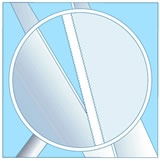 These hairdressing scissor blades are beveled and have small teeth (micro-notches) on the cutting edge that serve to conical haircut, ladder haircut and classic comb haircut technique. After the initial sharpening, a micro-notch is applied to one of the blades, which prevents the hair from slipping off during the haircut, especially when wet. Also, this type of hairdressing scissors is suitable for beginner hairdressers who are in the process of improving their cutting technique. Another advantage of this sharpening is the wear resistance of the cutting edge, especially when cutting dry hair.
These hairdressing scissor blades are beveled and have small teeth (micro-notches) on the cutting edge that serve to conical haircut, ladder haircut and classic comb haircut technique. After the initial sharpening, a micro-notch is applied to one of the blades, which prevents the hair from slipping off during the haircut, especially when wet. Also, this type of hairdressing scissors is suitable for beginner hairdressers who are in the process of improving their cutting technique. Another advantage of this sharpening is the wear resistance of the cutting edge, especially when cutting dry hair.
3.2. Honed cutting edges of hairdressing scissors
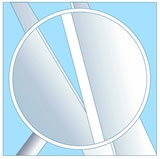 Honing of cutting edges of scissors – it is fine polishing and drawing them by hand, which provides a perfect "fine" hair cutting. The cutting edges of scissors are initially sharpened and then polished so that all irregularities are removed from the cutting surface. This results in a razor-sharp edge that allows you to literally shave your hair with scissors.
Honing of cutting edges of scissors – it is fine polishing and drawing them by hand, which provides a perfect "fine" hair cutting. The cutting edges of scissors are initially sharpened and then polished so that all irregularities are removed from the cutting surface. This results in a razor-sharp edge that allows you to literally shave your hair with scissors.
3.3. Curved edge
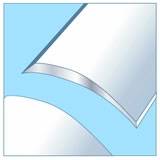
The curved edge provides the same scissor performance as hand sharpening, honing and convection sharpening. The cutting edge of the blades is not inclined at an angle, however, the curved edges provide strength and sharpness to this type of scissors.
3.4. Concave or convection cutting blades
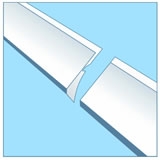
This type of blade is popular with professional stylists who prefer precise, smooth and fast cuts. These scissors are suitable for slicing, as well as for all types and techniques of haircuts. It is also worth noting that they provide accuracy and ease of use. The blades of these scissors are convex and are simply honed and polished and then convexed during convection sharpening, which gives them a razor-like sharpness.
-
Handle shape for maximum convenience
The next factor to consider when choosing hairdressing scissors – their style and form of capture.
There are two main forms of scissors – classic (straight) and ergonomic (curved).
4.1. Classic (straight) hairdressing scissors
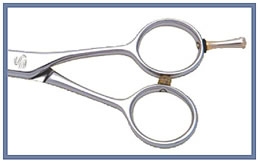
The straight shape is for you if you prefer to cut with your thumb and middle finger holding the scissors. The handles of such scissors are of the same length and diverge symmetrically from the handle to the rings. The scissor rings are also symmetrical and located in the same plane.
4.2. Ergonomically curved barber scissors
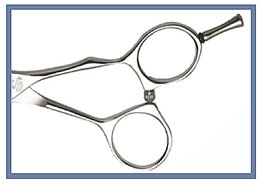
If you prefer to cut with your thumb and ring finger, the curved ergonomic hair scissors will suit you best. One half of these scissors (for the thumb) is shorter than the other (for the guide finger). This allows the arms to perform smoother and more familiar movements for you.
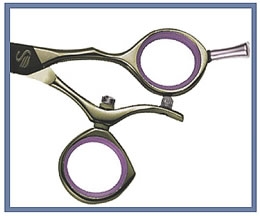
One of the most convenient types of hairdressing scissors are scissors with finger support. The finger rest replaces the third ring of the scissors and provides more stability and control while the thumb is free to move. Even greater freedom of movement is provided by scissors, the design of which takes into account the anatomical features of the hand of the master – they allow the thumb to relax and cut more precisely, while the guide ring finger can rest on the finger rest.
For a haircut with full freedom of movement, professional stylists will need curved scissors with a movable thumb ring. Such a ring rotates freely and allows the finger to move anatomically correctly, providing a pleasant and relaxed work. These scissors perfectly adapt to the ergonomics of the hand, so that the muscles are less tense during work. The handle of such scissors allows you to reduce the risk of developing carpal tunnel syndrome and tendinitis – one of the most common occupational diseases of hairdressers.
-
How steely are your hairdressing scissors?
Hairdressing scissors are made from various grades of stainless steel.
Standard. Hairdressing scissors for home use and training are usually made of stainless steel with sufficient quality characteristics, which is relatively inexpensive. Such steel must have the necessary strength, workmanship and must not rust.
High quality. Hairdressing scissors that meet higher quality standards are subjected to additional manufacturing processes, so the master ends up with a pair of scissors of maximum sharpness and durability. Some hairdressing scissors are also coated with special alloys that extend their life.
The hardness of steel is determined on the Rockwell scale.
Standard stainless steel. Wear-resistant stainless steel is characterized by hardness on the Rockwell scale – 52 units. If such steel is used to make scissors with micro notches (teeth), they will last quite a long time.
High quality stainless steel. Honed scissors made of stainless steel with a hardness of up to 57 HRC are especially suitable for long-term use and manual shearing.
Heat-treated steel can reach a hardness of up to 61 units and will last a very long time. In addition, it is an excellent material for scissors with convection blades.
Steel treated with heat and cold reaches a hardness of up to 67 units; such steel is treated with heat three times and then exposed to low temperatures. This steel has exceptional wear resistance and is an ideal material for convection shears, which we use very often.
-
Correct screw fastening system for hairdressing scissors
The scissor screw fastening systems vary depending on the scissor manufacturer. The main thing in this business – optimum tension. The screw can come loose at any time during cutting. If the screw is too loose, the cutting blades are damaged and begin to break and chew the hair. A screw that is too tight also has a negative effect on the cutting blades. It is recommended that the setting of the cutting blades be left exclusively to a specialist, otherwise the scissors may become unusable very soon.
6.1. Scissors with simple single screw fastening
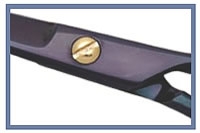 If the scissors are mounted on a single screw, they are equipped with a special washer, and the tension of the blades is adjusted with a screwdriver.
If the scissors are mounted on a single screw, they are equipped with a special washer, and the tension of the blades is adjusted with a screwdriver.
6.2. Central screw tension system
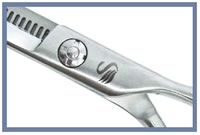 This system consists of two screw parts, so that the tension of the scissor blades can be precisely adjusted using a special key.
This system consists of two screw parts, so that the tension of the scissor blades can be precisely adjusted using a special key.
6.3. Flat spring screw system
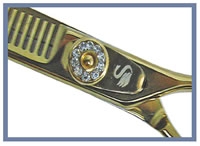 This screw system consists of three parts. The system is designed with a flat spring that provides additional tension for fine tuning. Such a screw system is the easiest to use, since it does not require additional tools. In addition, scissors equipped with such a system can be decorated with rhinestones or other decorative elements.
This screw system consists of three parts. The system is designed with a flat spring that provides additional tension for fine tuning. Such a screw system is the easiest to use, since it does not require additional tools. In addition, scissors equipped with such a system can be decorated with rhinestones or other decorative elements.
-
Rules for the care of hairdressing scissors
Whatever the price range of your hairdressing scissors, proper tool care is essential for best results, as cutting blades that have been damaged by misuse may not be repairable at all.
To keep your scissors in perfect condition, cleaning them of hair residues, chemicals and other used products will help. To do this, it is enough to wipe the scissors dry after each haircut.
After the end of the working day, it is recommended to wipe the scissors with a soft cloth to remove all hair residues from them, and then apply special scissor oil to the entire inner surface of the cutting blades. After applying the oil, carefully open and close the scissors so that the oil is distributed over the entire surface. Keep scissors in a protective bag or case – individual for each pair of scissors.
Remember that hairdressing scissors should only be used for their intended purpose – for cutting hair. Do not use your tool to cut hard or blunt objects, do not use it as a pair of pliers.
Regular sharpening of hairdressing scissors should be trusted only by proven specialists – this way you will keep your tool in good condition and maximize its life.






Add a comment